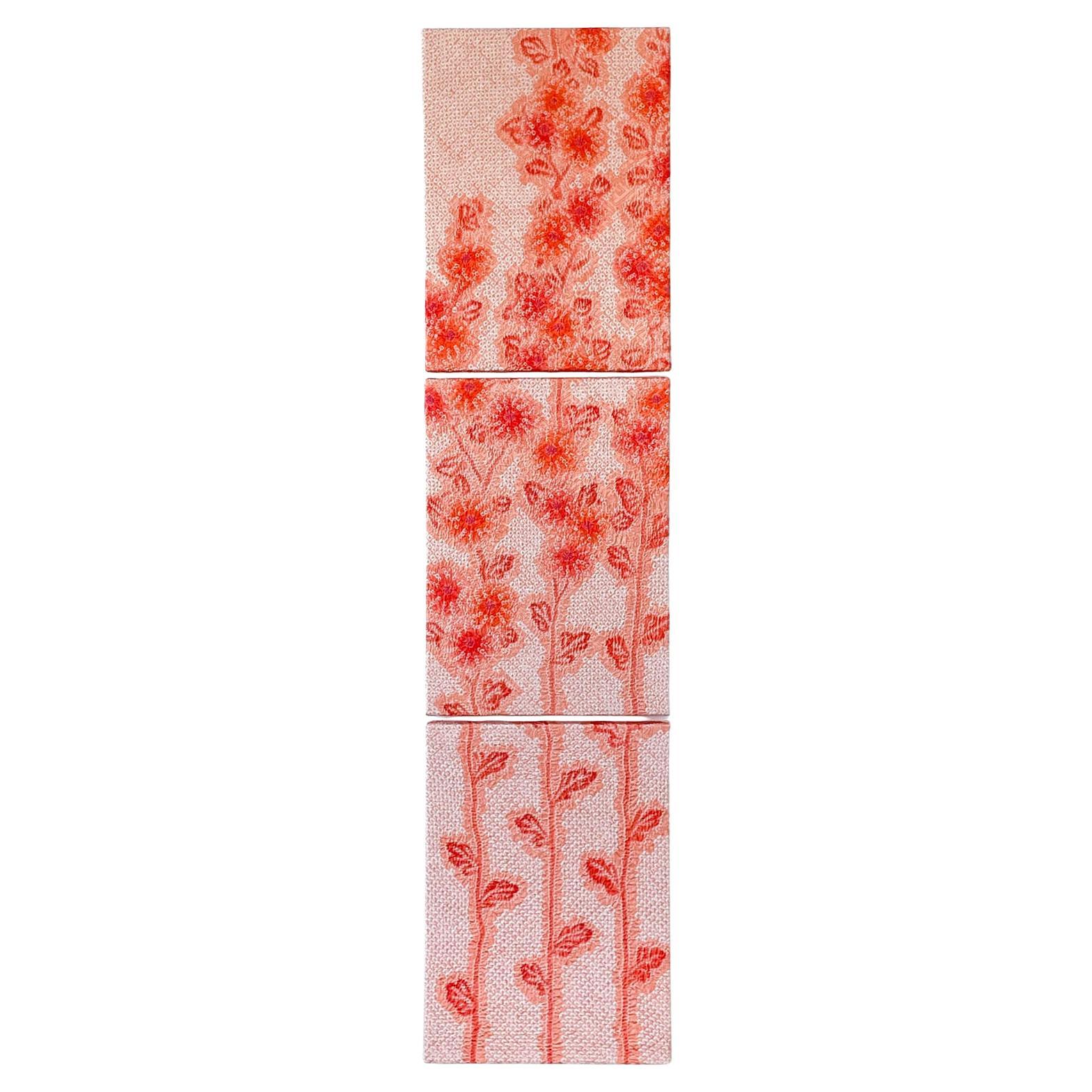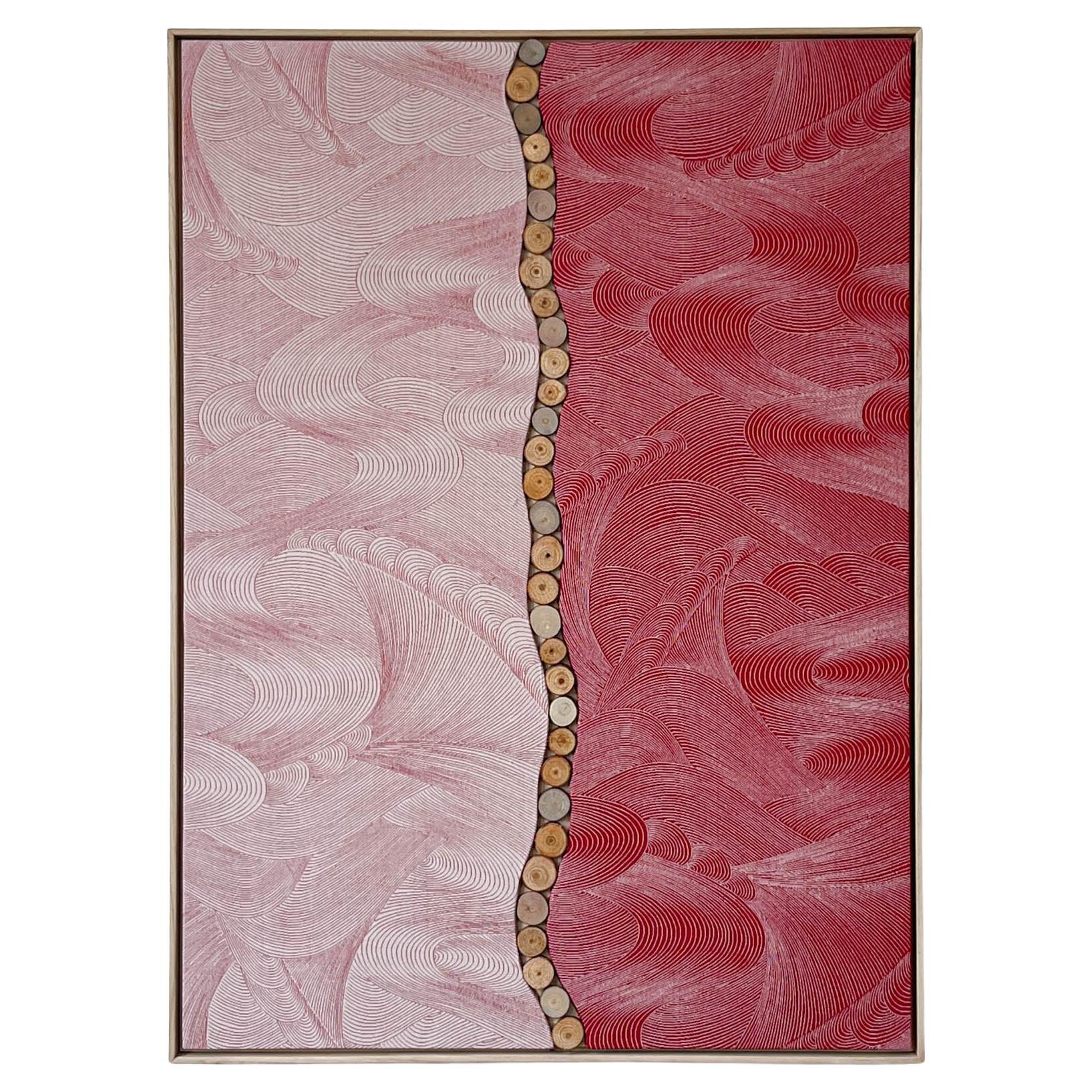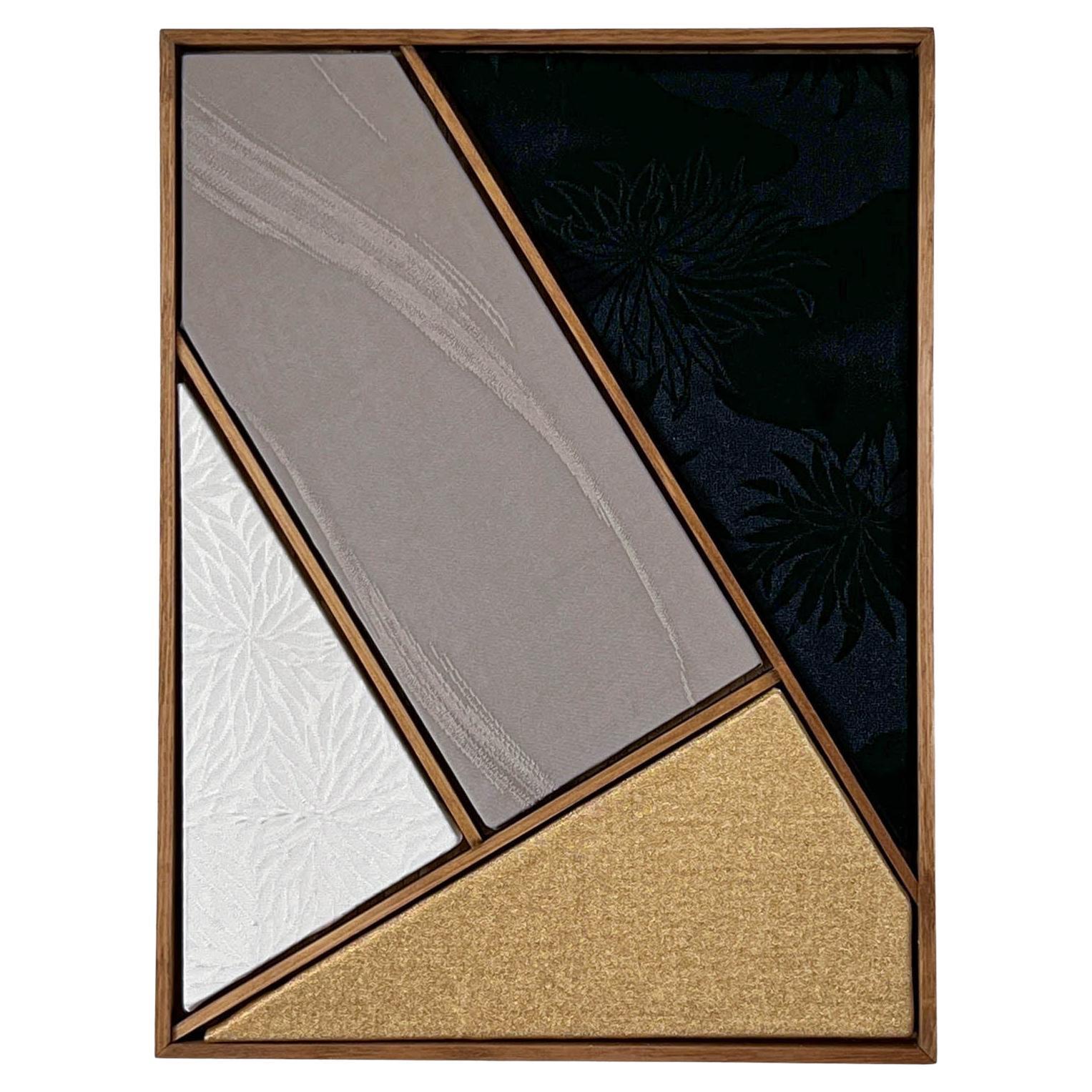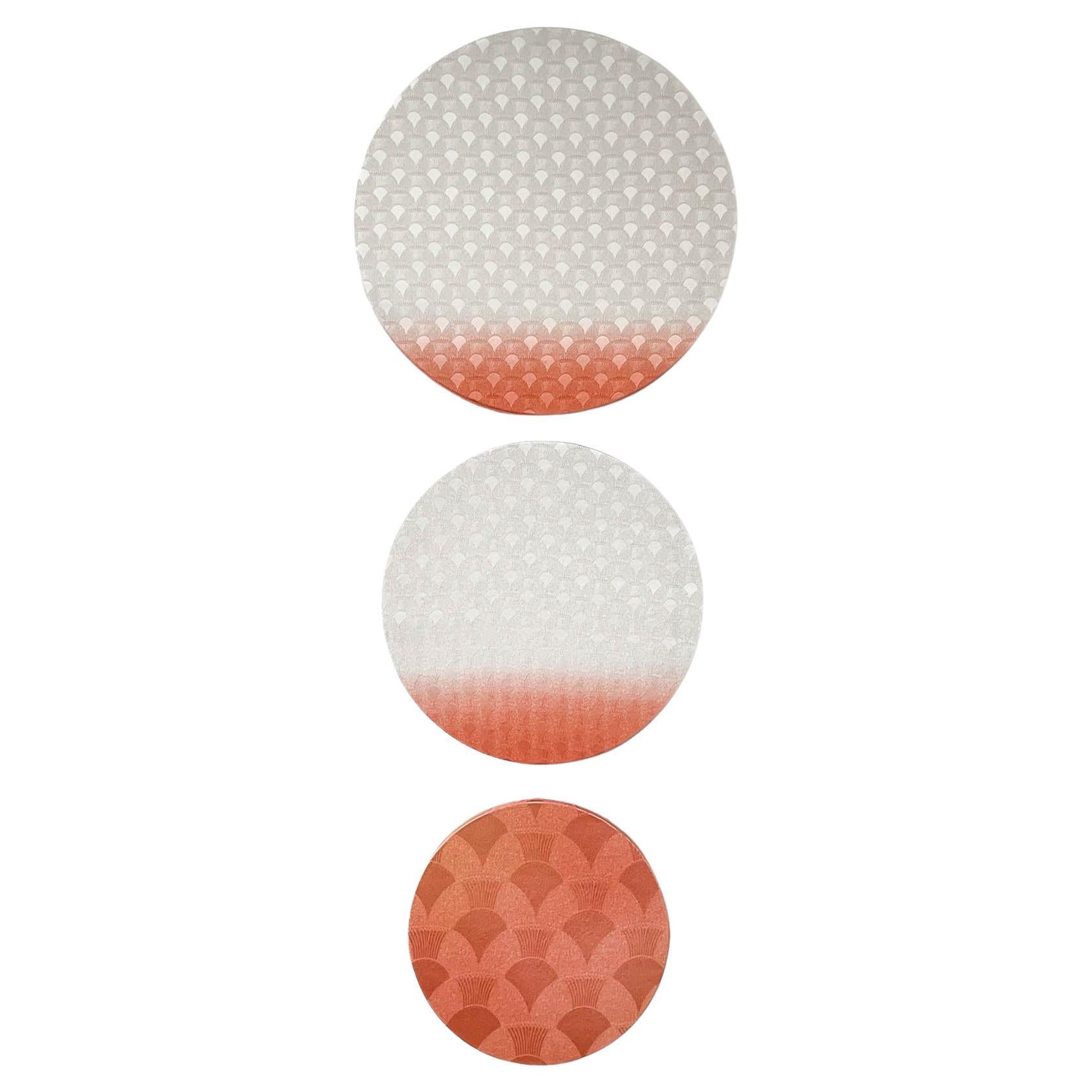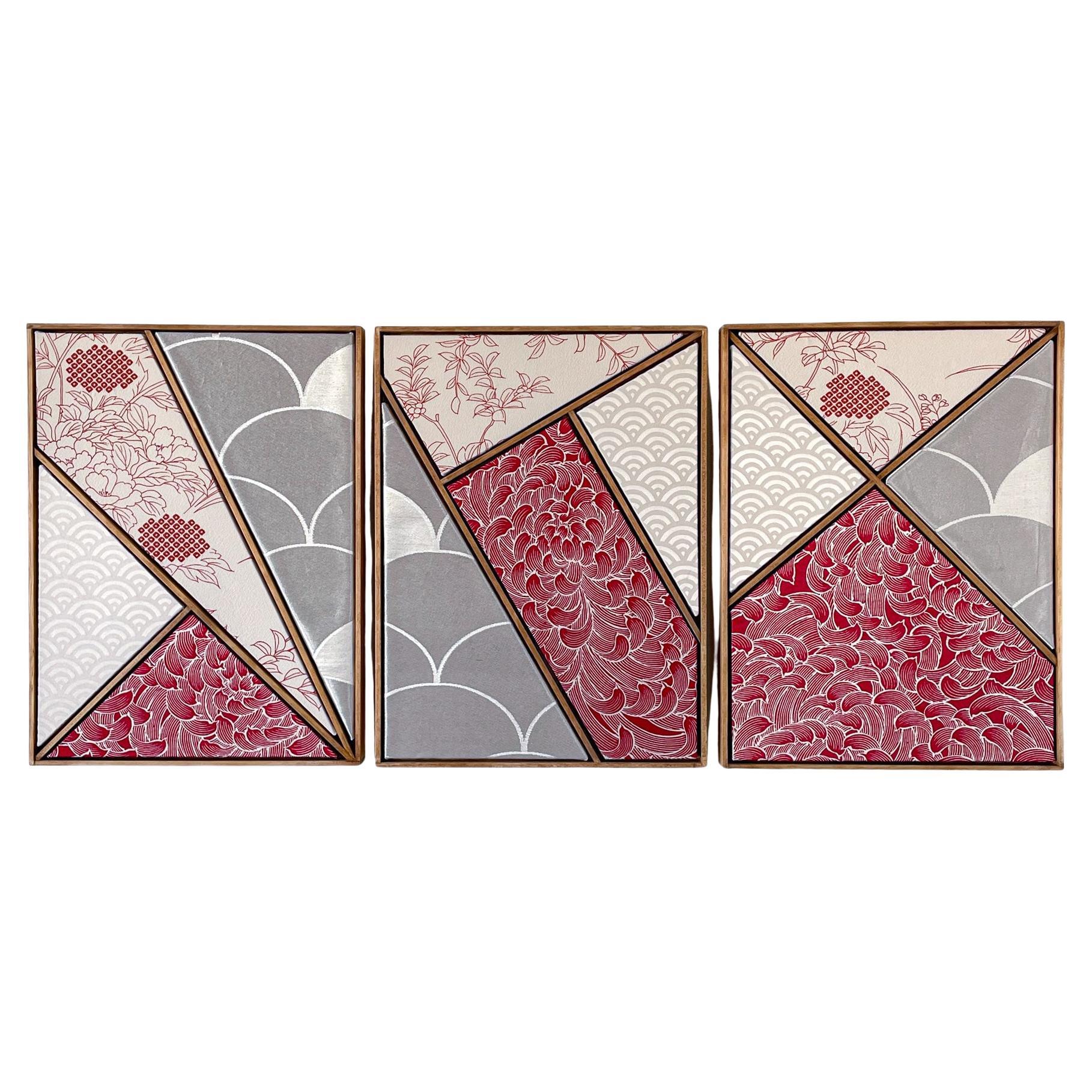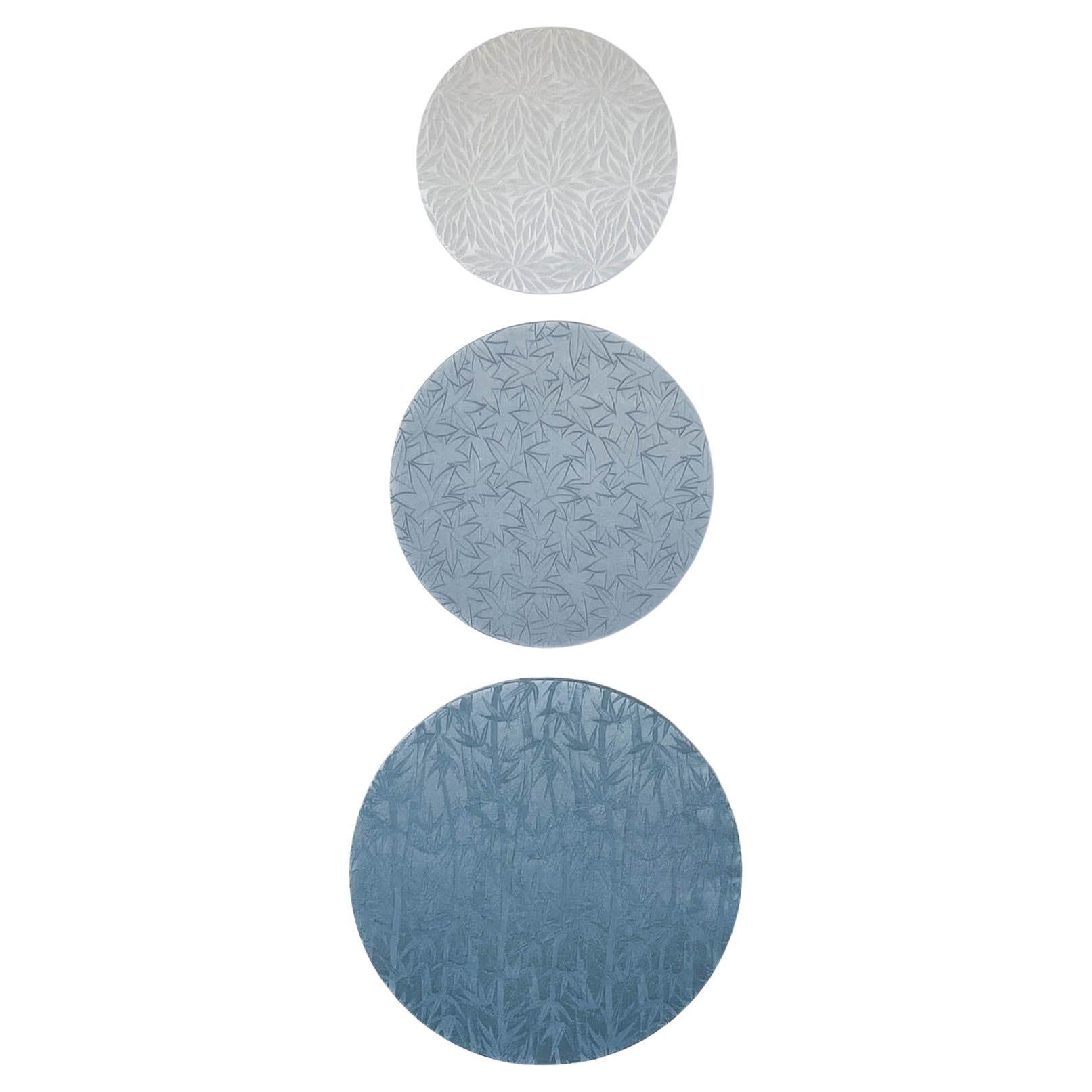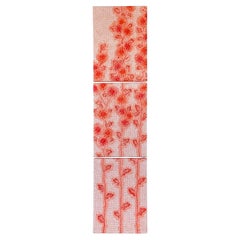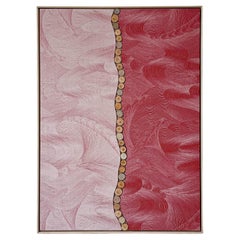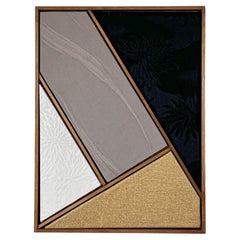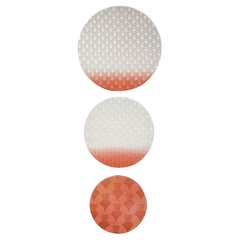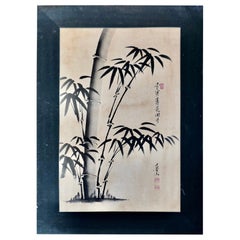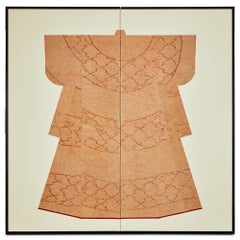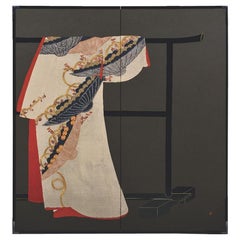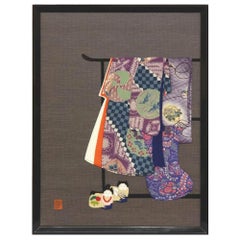Items Similar to Vintage kimono textile art "Snowflake ~New Beginnings~" by ikasu Purple, Japan
Want more images or videos?
Request additional images or videos from the seller
1 of 12
Vintage kimono textile art "Snowflake ~New Beginnings~" by ikasu Purple, Japan
About the Item
Six canvases (Diameter approx. 30cm, 25cm, 20cm) use the fabric taken from antique kimono, its' various parts, to create one harmonious fluid image of a snowflake - a symbol of new beginnings in Japan.
<< Period / Story >>
The kimono used for this canvas was created during the late Showa period (1960-80ies).
<< Explanation and meaning of pattern and colors >>
In Japanese tradition, the snowflake motif (雪華, sekka) carries deep cultural symbolism. It represents purity, transience, and the fleeting nature of life. Snowflakes, with their delicate structure and short-lived beauty, align with the concept of mono no aware (物の哀れ), the Japanese aesthetic appreciation of the ephemeral nature of things. This concept reveres beauty in its impermanence, reflecting the Buddhist-inspired idea that all things are transient.
Snowflake patterns in art, kimono, and textiles are particularly popular in winter designs, symbolizing peace, serenity, and clarity. The symmetry and delicacy of snowflakes also embody a sense of elegance and refinement, qualities often admired in Japanese art and aesthetics. In traditional kimonos, the snowflake motif can add a touch of seasonal beauty and evoke feelings of quiet winter landscapes, enhancing the garment's connection to nature and the changing seasons.
<< Characteristics of the fabric >>
Shibori is a traditional Japanese dyeing technique that involves folding, twisting, binding, or stitching fabric before dyeing to create intricate patterns. This resist-dyeing method results in unique, organic designs, often characterized by soft, blurred edges and beautiful contrasts, commonly seen in indigo-blue hues.
Snowflakes and small plum flower buds are created by shibori dyeing here.
- Creator:Kimono ikasu (Artist)
- Dimensions:Height: 0.79 in (2 cm)Diameter: 11.82 in (30 cm)
- Style:Japonisme (In the Style Of)
- Materials and Techniques:
- Place of Origin:
- Period:
- Date of Manufacture:1970ies
- Condition:
- Seller Location:Setagaya City, JP
- Reference Number:1stDibs: LU10079243793552
About the Seller
New to 1stDibs
Joined in the past six months.
No Reviews Yet
Vetted Professional Seller
Every seller passes strict standards for authenticity and reliability
1stDibs seller since 2024
- ShippingRetrieving quote...Shipping from: Setagaya City, Japan
- Return Policy
Authenticity Guarantee
In the unlikely event there’s an issue with an item’s authenticity, contact us within 1 year for a full refund. DetailsMoney-Back Guarantee
If your item is not as described, is damaged in transit, or does not arrive, contact us within 7 days for a full refund. Details24-Hour Cancellation
You have a 24-hour grace period in which to reconsider your purchase, with no questions asked.Vetted Professional Sellers
Our world-class sellers must adhere to strict standards for service and quality, maintaining the integrity of our listings.Price-Match Guarantee
If you find that a seller listed the same item for a lower price elsewhere, we’ll match it.Trusted Global Delivery
Our best-in-class carrier network provides specialized shipping options worldwide, including custom delivery.More From This Seller
View AllVintage kimono textile art " Growing ~ Longevity ~ " by ikasu Pink, Japan
By Kimono ikasu
Located in Setagaya City, JP
<< About this canvas >>
This set is a depiction of a tall chrysanthemum stem, entirely dyed in a traditional shibori technique.
<< Period / Story >>
The haori featured in this canvas was created and used during the late Showa period (1960-80ies).
<< Explanation and meaning of pattern and colors >>
A charming chrysanthemum flowers all around a stem seem to reach the heavens.
The chrysanthemum flower, which retains its vitality long after being cut, symbolizes longevity, purification from malevolent spirits, and good fortune. In ancient times, during the Kamakura period (1185-1333), emperors loved the chrysanthemum pattern, and it remains the most prestigious flower and the emblem of the Japanese imperial family...
Category
Vintage 1970s Japanese Japonisme Paintings and Screens
Materials
Canvas, Silk
Vintage kimono textile art "Sunset Timelapse ~Ephemerality~" by ikasu Red, Japan
By Kimono ikasu
Located in Setagaya City, JP
The art piece uses two sides - front and reverse - of the same kimono, to show beautiful sea surrounding Japan, in hues and in late sunset, as a timelapse.
The frame for this work is made of paulownia wood taken from antique Kiritansu - chest-of-drawers for kimono.
I use antique kiritansu that can’t be used as furniture anymore to create basis and frames for my works. It adds them even more authentic atmosphere of traditional wabisabi spirit. Can you feel it?
<< Period / Story >>
The kimono used in this piece was originally crafted during Showa period (around 1960ies).
<< Explanation and meaning of pattern and colors >>
Sea waves, depicted in two color variations here, are a symbol of transience and Impermanence in Japanese culture. The ebb and flow of the tides, the ever-changing currents, and the relentless motion of the waves serve as reminders of the fleeting nature of life. This artwork featuring the sea convey themes of impermanence, reminding viewers to cherish the present moment and appreciate the beauty of life's fleeting moments.
The theme of impermanence is strengthen by two colors of the sea - the lighter in early hues and the darker when the sun is just about to set in the sea.
<< About the frame >>
This artwork frame is crafted from paulownia wood, a uniquely Japanese material closely tied to the world of kimonos, and it serves to convey the refined beauty of Japanese nature.
Paulownia wood is known as the lightest wood in Japan, prased for its natural luster, resistance to moisture, and resilience against cracking. Since ancient times, it has been used in crafting furniture, chests, and musical instruments.
Paulownia wood is closely linked to kimono culture. During the Edo period (17th cent.~), it became customary to store cherished kimonos in paulownia chests...
Category
Vintage 1960s Japanese Japonisme Paintings and Screens
Materials
Silk, Wood
VIntage kimono textile art " Monochrome Geometry " by ikasu Gold, Grey, Japan
By Kimono ikasu
Located in Setagaya City, JP
This work is inspired by traditional Japanese nature colors symbolism, and is framed in paulownia wood originally used for a kimono chest-of-drawers.
It is filled with storytelling ...
Category
Vintage 1960s Japanese Japonisme Paintings and Screens
Materials
Silk, Wood
Vintage kimono textile art " Plum Gradation " by ikasu Pink, White, Japan
By Kimono ikasu
Located in Setagaya City, JP
This canvas featuring a plum color gradient kimono showcases a unique decorative variation of the popular seigaiha (青海波) sea waves pattern.
The artwork got a Mr. & Mrs. Abe Arts & Cu...
Category
Vintage 1980s Japanese Japonisme Paintings and Screens
Materials
Canvas, Silk
VIntage kimono textile art "Geometry ~Chrysanthemums" by ikasu, white, red Japan
By Kimono ikasu
Located in Setagaya City, JP
This work is inspired by traditional Japanese natural symbolism, and is framed in paulownia wood originally used for a kimono chest-of-drawers.
It is elegantly framed with paulownia...
Category
Vintage 1960s Japanese Japonisme Paintings and Screens
Materials
Silk, Wood
Vintage kimono textile art " Turquoise Forest ~Strength~ " by ikasu Blue, Japan
By Kimono ikasu
Located in Setagaya City, JP
Fabrics featuring iconic Japanese plants like chrysanthemum, maple, and bamboo were gathered from various long underwear and kimono pieces to create a set of canvases (diameter 30, 25 and 20cm) showcasing exquisite gradations.
The top canvas, in pristine white, originates from long under-kimono, while the middle and bottom canvases are skillfully upcycled from kimono fabrics.
<< Period / Story >>
The long under-kimono and kimono fabrics used in these canvases were originally crafted and worn during the late Showa period (1960-80ies).
<< Explanation and meaning of pattern and colors >>
The pattern on the top canvas features a chrysanthemum, an auspicious emblem symbolizing longevity. It is affectionately referred to as the "raccoon dog chrysanthemum" due to the large, overlapping petals resembling the fur of a muzina, a creature similar to a raccoon dog or badger. This motif is highly popular in various plant-inspired designs and frequently seen in Edo komon, katazome, and jimon textiles.
The top canvas naga-juban under-kimono, being entirely white and devoid of any additional dyes, suggests its use as formal wear. Its pristine white hue accentuates the silk's luster when exposed to light and highlights the beauty of the woven patterns.
The fabric used here is rinzu, a type of fabric thinner than crepe de chine, characterized by its soft, smooth texture and subtle sheen. This particular lintel distinguishes itself with the way its ground pattern emerges and also incorporates a woven chrysanthemum pattern.
The central canvas showcases a maple tree, symbolizing longevity, which changes its colors with the seasons, bringing joy and happiness to people's lives.
The bamboo featured on the lower canvas has been regarded as a symbol of good fortune since ancient times, given its straight and vigorous growth, along with the Chinese legend that a phoenix consumes its fruit. It embodies concepts such as "immortality," "longevity," and "strength" because it remains green even in winter. The hollow stem also signifies "innocence," suggesting that there are no hidden agendas.
All three canvases are adorned with ground patterns that, when viewed from a distance, appear as modern works of art, yet upon closer inspection, they reveal a distinct Japanese ambiance.
<< Characteristics of the fabric >>
All three canvases are made of fabrics with jimon. The unique and high level of Japanese weaving...
Category
Vintage 1970s Japanese Japonisme Paintings and Screens
Materials
Canvas, Silk
You May Also Like
Vintage Bamboo Japanese Art, Wall Art 5 excellent pieces
Located in Chillerton, Isle of Wight
Vintage Bamboo Japanese Art, Wall Art
5 excellent pieces, on cartridge paper set on Black Silk
Wonderful Vintage pieces, from 1980, 21.5” high, 15.5” wide
ZX281
Category
Vintage 1980s Japonisme Paintings and Screens
Materials
Paper
Japanese Two Panel Screen: Kimono
Located in Hudson, NY
Beautiful 19th century shibori (pin dyed) fabric in kimono form mounted on a simple ground of mulberry paper. Black lacquer trim with beautifully designed bronze mounts. The fabric ...
Category
Early 20th Century Paintings and Screens
Materials
Fabric, Wood, Lacquer, Paper
Japanese Contemporary Red Black Cream Folding Screen Silk Brocade Kimono Art, 3
Located in Takarazuka, JP
Exceptional Japanese contemporary two panel "byobu" or folding screen featuring genryoku style handcrafted silk raised kimono Japanese decorative art in crimson red, black and gold o...
Category
21st Century and Contemporary Japanese Meiji Paintings and Screens
Materials
Gold
Japanese Contemporary Framed Blue Purple Gray Silk Brocade Decorative Art
Located in Takarazuka, JP
Japanese contemporary framed three-dimensional decorative art piece in Japanese traditional silk and brocade in soft green, blue and purple on a deep gray background, recreating an 1...
Category
21st Century and Contemporary Japanese Meiji Paintings and Screens
Materials
Brocade, Silk
Japanese Two Panel Screen: Antique Kimono Fabric Mounted on Screen
Located in Hudson, NY
Japanese Two Panel Screen: Late Nineteenth Century Kimono Fabric Mounted on Early Twentieth Century Screen. In the Heian period (eighth century to the twelfth century), noblemen wou...
Category
Early 20th Century Japanese Meiji Paintings and Screens
Materials
Silk, Wood, Paper
Japanese Two Panel Screen Geometric Design on Mounted Textile
Located in Hudson, NY
In strong primary colors. Makers seal reads: Yu.
Category
Mid-20th Century Japanese Paintings and Screens
Materials
Paint
Recently Viewed
View AllMore Ways To Browse
Vintage Concept
Japanese Kimono
Japanese Used Kimono
Antique Purple Flowers
Vintage Fabric Screen
Vintage Japanese Hand Painted
Vintage Kimonos
Blue Kimono
Shibori
Vintage Kimono Japan
Fabric Folding Screen
Antique Fold Screen
Japanese Kimono Fabric
1970 Kimonos
Blue Snowflake
Indigo Vintage Textile
Japanese Indigo Textile
Vintage Kimono Fabrics
